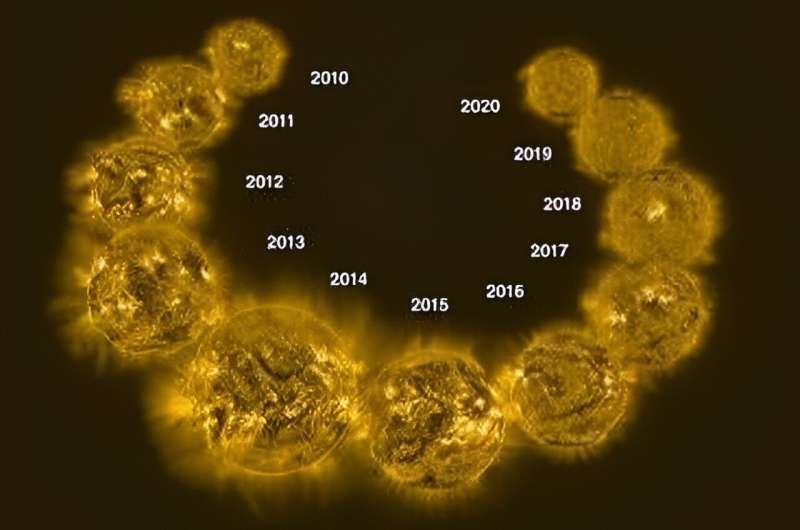This article has been reviewed according to Science X's editorial process and policies. Editors have highlighted the following attributes while ensuring the content's credibility:
fact-checked
peer-reviewed publication
trusted source
proofread
Better math adds up to trillions in climate-related savings: Statisticians curb uncertainty in climate models

A new study greatly reduces uncertainty in climate change predictions, a move economists say could save the world trillions in adaptations for a hotter future. The study, published in the journal Nature Communications, considers dozens of climate models from different countries that differ in the magnitude of global warming they predict to occur by the end of the century.
Warming in these models is caused by emissions of carbon dioxide, or CO2, in the atmosphere. CO2 is a greenhouse gas, which creates a kind of blanket in the atmosphere, trapping heat from Earth's surface and preventing it from radiating into space.
"All of the models predict warming when CO2 is doubled. But their predictions vary greatly from each other, from 1.3 to 3 degrees Celsius. And that is a problem," said King-Fai Li, the study's first author and UC Riverside assistant professor of environmental science and statistics.
The 2015 Paris Agreement aims to keep future global warming to below 1.5 degrees Celsius to avoid irreversible damage. Climate models predicting 1.3 degrees Celsius warming by the end of the century imply a more relaxed timeline for humanity to reverse climate change. However, the prediction of 3 degrees of warming by other models suggests much more urgent action is needed.
"Other studies have found that a rush adoption of immature technology for renewable energy may cause economic harm to the tune of tens of trillions of dollars," said Ka-Kit Tung, the study's corresponding author at the University of Washington.
There has also been some argument among prominent climate scientists about whether the latest generation of climate models compiled by the Intergovernmental Panel on Climate Change run too hot, meaning they wonder whether the projected warming is too great.
"There's a question about whether these climate models are trustworthy," Li said. All climate models can accurately simulate known historical warming in the past 150 years, but their predictions of future warming diverge even given the same emission scenarios. This is where the current dilemma lies.
"We depend on models to tell us exactly how hot the future might be, but different models predict different degrees of warming by the end of this century," Li said. "The uncertainty generated by these differences has persisted for four decades, despite great efforts to reduce it."
To increase the specificity of the predictions, and to gauge their accuracy, Li and Tung used a natural phenomenon—the 11-year solar cycle—to probe Earth's climate response to increased CO2 in the atmosphere.
In 1613, Galileo Galilei used a newly-invented telescope and discovered dark spots moving across the surface of the sun. The number of sunspots changes over time, in cycles. The 11-year sunspot cycle, as it is now known, affects the radiation reaching the Earth, getting alternately stronger and weaker.
"Every time the sun naturally gets hotter, it increases radiation that goes into the atmosphere on Earth," Li said. The changes in solar radiation have been measured by orbiting satellites since the 1970s.
During roughly five-year periods where the sun's radiation gets stronger, the average Earth surface temperature goes up by 0.1 degree Celsius. Though this amount of warming is much smaller than likely warming due to CO2 increases, the way Earth responds to sunspots and CO2 is analogous.
"A model with a weak response to the 11-year solar cycle also produces a weak response to the CO2 increase. Only models that can produce a solar cycle response consistent with observation could be trusted to produce the correct warming due to greenhouse gases," Li said.
Li and Tung found eight models that agree within the uncertainty range of the observed solar-cycle responses, and they concluded that these models are generally not overpredicting the amount of warming or running too "hot." The value they predict is about 2.2 degrees Celsius by the time the amount of CO2 in the atmosphere doubles over preindustrial values.
Some economists have estimated that reducing the uncertainty spread in climate predictions by half could save the world $10 trillion. This study went further than that, reducing the spread by two-thirds.
Pleased by this outcome, the researchers hope to further emphasize the value of using the information to bolster infrastructure.
"There are some who don't understand the gravity of the world's climate situation. They do not understand that the tipping point occurs once, and once we reach it there is no way to come back," Li said.
"The heat waves, droughts, megafires, and in some places, cold surges—the consequences will be disastrous in terms of damage and life loss. Better predictions about what our world will be like 100 years from now give us a fighting chance of adapting."
More information: King-Fai Li et al, Solar cycle as a distinct line of evidence constraining Earth's transient climate response, Nature Communications (2023). DOI: 10.1038/s41467-023-43583-7
Journal information: Nature Communications
Provided by University of California - Riverside




















